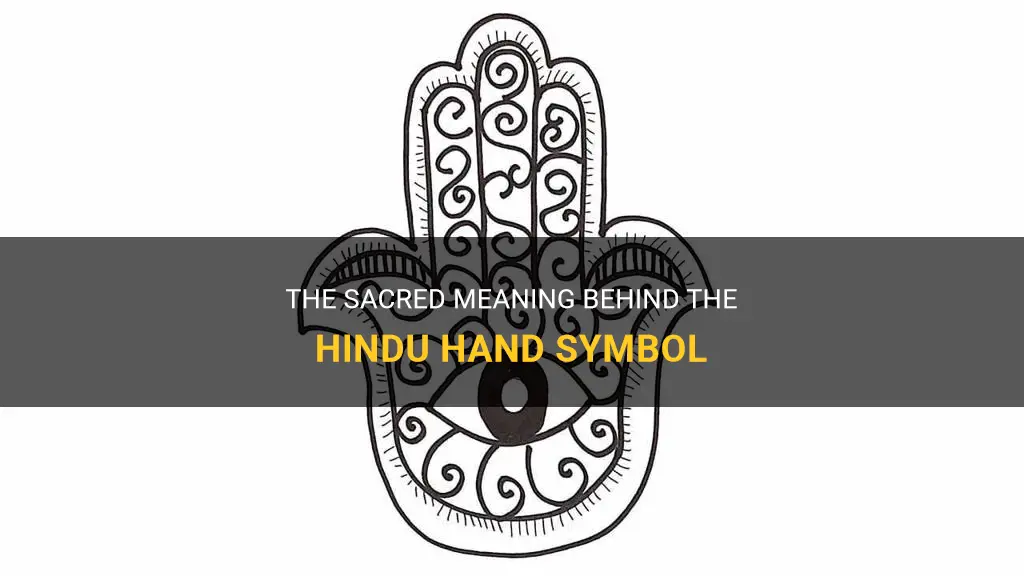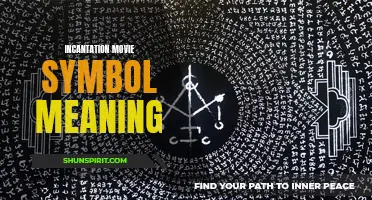
The Hindu hand symbol, also known as hasta mudras, is a powerful and versatile symbol used extensively in Hinduism. Its significance goes beyond a mere gesture, as each hand position holds a deeper meaning and purpose. These sacred hand symbols serve as a bridge between the physical and spiritual realms, imbuing the practitioner with spiritual energy and unlocking hidden potentials. From calming the mind to invoking divine blessings, each mudra has a unique purpose, making the Hindu hand symbol an intriguing and captivating aspect of Hindu culture and spirituality.
What You'll Learn
- What is the Hindu hand symbol called and what is its meaning?
- How is the Hindu hand symbol used in Hindu ceremonies and rituals?
- Are there variations of the Hindu hand symbol and do they have different meanings?
- What are some common misconceptions or misunderstandings about the Hindu hand symbol?
- Can non-Hindus use or wear the Hindu hand symbol, or is it strictly for members of the Hindu faith?

What is the Hindu hand symbol called and what is its meaning?
The Hindu hand symbol is known as "Mudra," which translates to "seal" or "gesture" in Sanskrit. Mudras are hand positions or gestures that are used in Hindu rituals, yoga, and meditation. These hand gestures are believed to have specific meanings and can facilitate the flow of energy, awakening spiritual powers, and promoting healing.
One of the most well-known Hindu hand symbols is the Anjali Mudra, also known as the Namaste Mudra. This mudra is commonly used as a greeting and a sign of respect in Hindu culture. To perform the Anjali Mudra, one brings the palms of the hands together in front of the heart chakra, with fingers pointing upwards. The thumbs are lightly pressed against the chest, and the hands are held close to the body.
The Anjali Mudra is a symbol of unity, gratitude, and reverence. It is a gesture that acknowledges the divine in oneself and others. By bringing the palms together, one unifies the left and right sides of the body, representing the balance of opposites. It signifies the merging of the individual self with the universal consciousness.
In addition to the Anjali Mudra, there are numerous other mudras used in Hindu traditions. Each mudra has a unique purpose and is believed to create specific energetic effects. For example, the Gyan Mudra is performed by touching the tip of the index finger to the tip of the thumb, while keeping the other fingers extended. This mudra is associated with knowledge, wisdom, and concentration.
Another popular mudra is the Apana Mudra, where the tips of the middle and ring fingers touch the tip of the thumb, while the other fingers are extended. The Apana Mudra is believed to stimulate the elimination of toxins from the body and promote physical and mental cleansing.
Mudras are not only used in spiritual practices but also in yoga and meditation. Practitioners often incorporate specific mudras into their practice to deepen their focus, enhance energy flow, and cultivate specific qualities or states of mind.
In conclusion, the Hindu hand symbol is called Mudra, and it encompasses a wide range of hand positions or gestures with specific meanings and purposes. One of the most well-known mudras is the Anjali Mudra, which represents unity, gratitude, and reverence. Mudras are used in Hindu rituals, yoga, and meditation to facilitate the flow of energy, awaken spiritual powers, and promote healing. They are a powerful tool for connecting with oneself and the divine.
The Symbolic Meaning of Daisy: A Flower Full of Innocence and Purity
You may want to see also

How is the Hindu hand symbol used in Hindu ceremonies and rituals?
The Hindu hand symbol, also known as the Hasta Mudra, is a significant aspect of Hindu ceremonies and rituals. These hand gestures hold deep symbolism and are believed to create a connection between the physical body and the divine energy. They are used to enhance the spiritual experience during various Hindu rituals.
There are numerous hand symbols in Hinduism, each having a specific meaning and purpose. These gestures are performed with different arrangements of fingers and palms, and each mudra signifies a particular intention or concept. The Hindu hand gestures are believed to channel cosmic energy and help individuals focus their concentration and intention during worship.
One of the most common hand symbols used in Hindu ceremonies is the Anjali mudra, which involves pressing the palms together at the heart center, similar to the popular prayer gesture. This mudra is a sign of greeting, respect, and reverence and is commonly used in various Hindu rituals, including welcoming deities during a puja or offering prayers to ancestors. It is a way of expressing devotion and surrendering to a higher power.
Another frequently used mudra is the Abhaya mudra, which involves raising the right hand with the palm facing outwards and fingers pointing upwards. This gesture signifies fearlessness, protection, and blessing. It is often used by deities to assure and console their devotees. The Abhaya mudra is commonly seen in the iconography of Hindu gods and goddesses such as Lord Ganesha and Goddess Durga.
The Apana mudra is another significant hand symbol in Hindu rituals. It is created by touching the tips of the middle and ring fingers with the thumb while keeping the other fingers extended. This gesture is believed to promote the elimination of toxins and negative energies from the body. It is commonly used during meditation and yoga practices to enhance focus and balance.
In addition to these, there are many other hand symbols used in Hindu ceremonies, such as the Varada mudra (gesture of granting wishes and blessings), the Chin mudra (gesture of consciousness and awareness), and the Jnana mudra (gesture of knowledge and wisdom).
During Hindu rituals and ceremonies, these hand symbols are often performed alongside various mantras and rituals. The combination of hand gestures, chants, and visualizations creates a powerful and sacred environment for spiritual practice. They help individuals connect with the divine energy and invoke the presence of deities during worship.
It is important to note that the significance and interpretation of each hand symbol may vary depending on the specific deity being worshipped, the ritual being performed, and the cultural traditions followed. Different regions and sects within Hinduism may have their own unique variations and interpretations of the hand gestures.
In conclusion, the Hindu hand symbol or Hasta Mudra plays an integral role in Hindu ceremonies and rituals. These hand gestures hold deep spiritual significance and are used to enhance the connection with the divine energy. Whether it is the Anjali mudra for greeting and respect or the Abhaya mudra for protection and blessing, these hand symbols help facilitate a deeper spiritual experience and connection with the divine.
The Language of Blooms: Exploring the Deep Meaning and Symbolism of Flowers
You may want to see also

Are there variations of the Hindu hand symbol and do they have different meanings?
The Hindu hand symbol, more commonly known as the Hamsa or the Hand of Fatima, is a popular motif found in various cultures and religions. It is characterized by a hand shape with an eye in the center and is believed to protect against evil spirits and bring good luck. While the basic symbolism remains the same, there are variations of the Hamsa that have different meanings.
One variation of the Hamsa is the two-handed symbol. This variant features two symmetrical hands facing each other and is believed to represent balance and harmony. It symbolizes the unity of male and female energies, as well as the balance between the spiritual and material worlds. The two-handed symbol is often used in weddings and is associated with fertility and prosperity.
Another variation of the Hamsa is the hand with the fingers pointing upwards. This variation is commonly associated with blessings and is believed to bring positive energy and protection. It is often used as a talisman to ward off negative influences and bring good fortune. The upward point of the fingers symbolizes the upward movement of energy and is believed to attract blessings from the universe.
The hand with an open palm is another variation of the Hamsa symbol. This variant is commonly associated with welcoming and receiving blessings. The open palm is believed to be a gesture of openness and acceptance, inviting positive energy and good fortune into one's life. It represents an attitude of gratitude and appreciation for the blessings received.
Additionally, there are variations of the Hamsa symbol that incorporate other elements. For example, some designs feature the Hamsa with a lotus flower, representing purity and enlightenment. Others include additional symbols such as the Om sign, representing the sacred sound of the universe, or the Tree of Life, symbolizing growth and strength.
In conclusion, while the basic symbolism of the Hindu hand symbol remains the same, there are variations of the Hamsa that have different meanings. The two-handed symbol represents balance and harmony, the upward-pointing fingers symbolize blessings and positive energy, and the open palm signifies welcoming and receiving blessings. These variations, along with additional elements incorporated into the design, add depth and complexity to the symbolism of the Hamsa.
The Meaning Behind Disability Symbols: Promoting Inclusion and Accessibility
You may want to see also

What are some common misconceptions or misunderstandings about the Hindu hand symbol?
The Hindu hand symbol, also known as the Mudra, is a sacred gesture used in Hindu rituals, yoga, and meditation. It holds great significance in Hinduism and is believed to have various spiritual and healing effects. However, there are several common misconceptions and misunderstandings surrounding this symbol that need to be addressed for a better understanding.
One common misconception is that the Hindu hand symbol is only associated with religious rituals. While it is true that the Mudra is used in Hindu religious ceremonies, its significance goes beyond religious practices. The Mudra is an integral part of yoga and meditation, where it is used to channel and control the flow of energy in the body. Each Mudra has a specific purpose, such as calming the mind, increasing concentration, or promoting overall well-being.
Another misconception is that all hand gestures in Hinduism are Mudras. While some hand gestures in Hindu rituals may resemble Mudras, not all of them are considered as such. Mudras are specific hand positions accompanied by specific breathing patterns and mental focus. They are intended to enhance the practitioner's physical, mental, and spiritual well-being.
It is also important to note that the Mudra is not exclusive to Hinduism. Similar hand gestures can be found in other ancient spiritual traditions, such as Buddhism and Jainism. These traditions share common roots and often overlap in their practices and rituals. The Mudra is a universal symbol of connecting with one's inner self and the divine energy.
Furthermore, there is a misconception that anyone can perform Mudras without proper guidance or understanding. While Mudras can be practiced by anyone, it is essential to learn them from a qualified teacher or practitioner who can provide proper guidance. Each Mudra has its own technique, purpose, and benefits, and it is crucial to learn and practice them correctly to reap their intended effects.
Additionally, there is a misunderstanding that the Mudra has immediate and miraculous effects. While some practitioners may experience immediate benefits, the Mudra is not a magical or instant solution to all problems. It requires regular practice, patience, and a holistic approach to achieve its full potential. Consistency and a deep understanding of the Mudra's purpose are key to harnessing its power.
In conclusion, the Hindu hand symbol, or the Mudra, is often surrounded by misconceptions and misunderstandings. It is not solely a religious symbol but also an integral part of yoga and meditation practices. Not all hand gestures in Hindu rituals are Mudras, and the Mudra is not exclusive to Hinduism. Proper guidance and understanding are necessary for effective practice, and the Mudra is not a quick fix but a tool for holistic well-being. By debunking these misconceptions, one can gain a deeper appreciation for the profound significance of the Mudra in Hinduism and other spiritual traditions.
Decoding the Miele Vacuum Symbols: What Do They Mean?
You may want to see also

Can non-Hindus use or wear the Hindu hand symbol, or is it strictly for members of the Hindu faith?
The Hindu hand symbol, also known as the Hamsa or Hand of Fatima, is a popular symbol in Hinduism and other faiths such as Judaism and Islam. It is a palm-shaped amulet that is often used as a sign of protection and good luck. While the symbol holds significant religious and cultural meanings, it is not strictly reserved for members of the Hindu faith.
The Hamsa hand symbol has a long history and is believed to date back thousands of years. It is commonly associated with the Hindu goddess Lakshmi, the goddess of wealth and prosperity, and is often used in Hindu religious ceremonies and rituals. However, the symbol is also recognized and revered by people from different religious backgrounds and cultures.
In Judaism, the Hamsa hand symbol is known as the Hand of Fatima or the Hand of Miriam, and it holds similar meanings of protection and good fortune. It is often used as a decorative item or as a pendant worn by individuals of Jewish faith.
Islam also recognizes the Hamsa hand symbol as the Hand of Fatima, which is named after Fatima Zahra, the daughter of the Prophet Muhammad. In Islamic tradition, the symbol is believed to bring blessings and protection from evil spirits. Muslims may use the symbol as a decorative item or wear it as a pendant or amulet.
Given its widespread recognition and universal meanings, the Hindu hand symbol is not exclusive to members of the Hindu faith. Non-Hindus are free to use or wear the symbol as an expression of their beliefs or for its protective and lucky connotations. It is considered a beautiful and meaningful symbol that transcends religious boundaries and is appreciated by people from different backgrounds.
It is worth noting, however, that when using or wearing the Hindu hand symbol, it is essential to do so with respect and an understanding of its cultural and religious significance. It is always advisable to learn about the symbol's meanings and ensure that it is being used in an appropriate and respectful manner.
In conclusion, the Hindu hand symbol, also known as the Hamsa or Hand of Fatima, is not strictly reserved for members of the Hindu faith. It is a symbol that holds significant religious and cultural meanings for Hindus, Jews, and Muslims alike. Non-Hindus are free to use or wear the symbol as an expression of their beliefs or for its protective and lucky connotations, but it is important to do so with respect and understanding.
The Hidden Meaning Behind TikTok's Triangle Symbol Explained
You may want to see also
Frequently asked questions
The Hindu hand symbol, also known as mudra, represents different meanings depending on the specific hand position. Each mudra is believed to create a specific energy flow in the body and stimulate specific emotions or qualities in the practitioner.
The "Namaste" hand gesture is a common mudra used in Hinduism and is a way of greeting and showing respect. The gesture involves placing the palms of the hands together and bowing the head slightly. It is believed to symbolize the recognition of the divine spark within oneself and in others.
The hand symbol of Ganesha, known as "Ganesha Mudra," is commonly associated with the Hindu god Ganesha. It is a mudra that represents wisdom, protection, and the removal of obstacles. This mudra is often used in meditation and is believed to invoke blessings and divine guidance.
The "Abhaya Mudra" hand gesture is a mudra commonly seen in Hindu deities and represents fearlessness and protection. The gesture involves raising the right hand, palm facing outwards, and is believed to ward off negative energies and instill courage and confidence.
The hand symbol of the lotus flower, known as "Padma Mudra," is often used in Hinduism and Buddhism and symbolizes purity and spiritual awakening. The gesture involves joining the palms of the hands together and opening them up like a blooming lotus flower. It is believed to evoke feelings of beauty, grace, and enlightenment.







